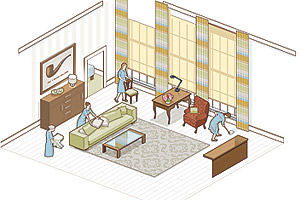
Size matters, says Sir Rocco Forte, especially when it comes to a hotel bathroom. Forte, 63, should know. Knighted by the Queen of England in 1994 for outstanding service to the U.K. tourism industry, he has spent a lifetime in hospitality: he is the former chairman and ceo of Forte Group PLC, which had more than 800 hotels when it was sold in 1996. In 1997, Sir Rocco acquired the Balmoral in Edinburgh, Scotland, as the cornerstone of what is currently an 11-strong five-star-hotel group called the Rocco Forte Collection, which emphasizes contemporary luxury — no gold taps here. Indeed, the only other job he has ever had was playing a waiter on TV when he was a teenager. Sir Rocco, who collaborates with his sister, interior-design director Olga Polizzi, works on both new constructions and refurbishment projects. 2009 will see the opening of properties in Sicily and Prague, and 2010, expansion beyond Europe into the Middle East and North Africa. His most ambitious renovation has been the reminting of the 1837 London hotel gem Brown's — where the Roosevelts once stayed and where Rudyard Kipling wrote The Jungle Book — which reopened in 2005 after a $24 million remodeling. Walking through Brown's, he discusses the many aspects that combine to make a great hotel experience.
Meet and Greet
A first-class hotel stay begins long before you lay eyes on your room, Sir Rocco says. Although many prospective guests visit the company's website, only about 10% book entirely online, the rest preferring to discuss their plans by phone. This gives a friendly staffer the chance to mention the benefits of upgrading to a suite. For convenience, confirmations are sent by e-mail, at guests' preference, despite Sir Rocco's favorite — "a beautiful letter on nice paper."
Room Numbers
To ensure that a guest feels like No. 1, the optimum number of rooms is 150, the point at which economies of scale really work. With fewer, the ratio of guests to staff at the five-star level requires very high prices; with more, personal service may suffer. (The Rocco Forte hotel in Abu Dhabi will have 270 rooms, made feasible by lower staffing costs in the Middle East.) "You don't want to get much above 200 rooms in Europe," says Sir Rocco, "unless you are the Four Seasons, a company I hugely admire."
Early-Bird Specials
Transatlantic arrivals to Europe tend to be in the early morning, requiring an administrative juggling act when check-in isn't until 2 p.m. Asking guests to reserve a room starting the night before may seem profitable for a hotel, but in fact it results in losses in potential spending on services, restaurant and bar. The better option is to find out guests' departure and arrival times and schedule housekeeping staff accordingly.
No Cookie-Cutter Design
At the five-star level, rooms should not be identical yet should be in tune with brand identity. Sir Rocco is opposed to "dècor that wows, because it palls just as fast." He favors instead an equation of contemporary comfort plus details such as well-chosen books to add warmth, attractive art and flourishes of frivolity. "But I leave decoration to my sister and the designers she chooses," he says. "I will look at the prototype room from a practical view: Is the bedroom reading light well placed and bright enough? Do the windows open? If that is possible, guests like it."
Space Sells
Old buildings present unique space challenges. The solution is to make one room as big as possible, favoring the bathroom over the bedroom. Double basins appeal, as does a huge bathtub (even if left unused). The travel-size toiletries are gifts to take if you wish. But leave that robe. The practice of chambermaids' removing robes from departing guests' luggage has been replaced by the appearance of an extra charge on one's bill, often before the guest has left the building. (Housekeeping informs the front desk right after you've left your room.)